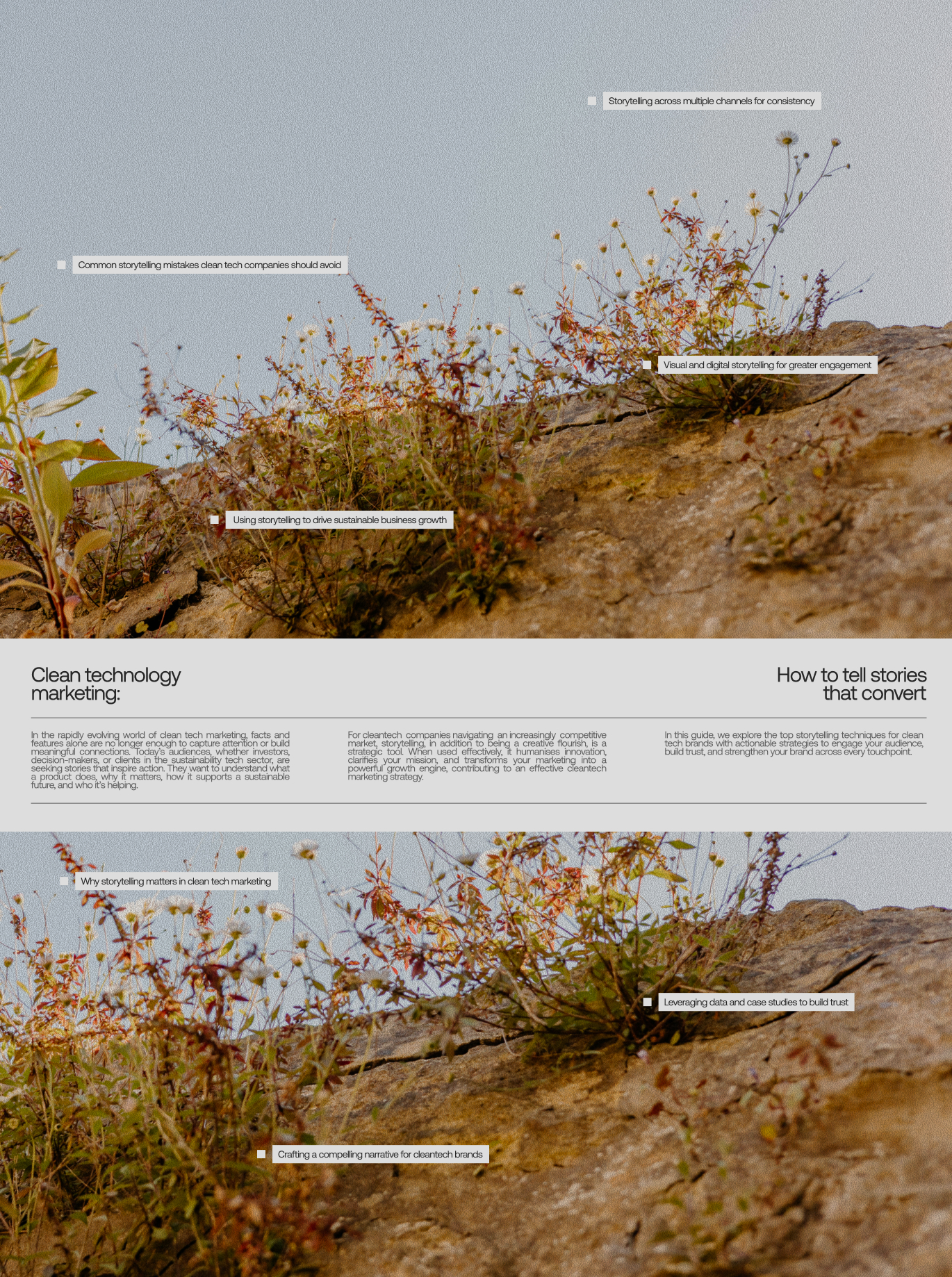

Marketing for tech startups: The cost of underinvesting in branding for climate tech companies
Branding
31/7/2025
Climate tech startups face pressure to prove value quickly, often prioritising product development, engineering talent, and investor relations. In the rush, branding is frequently treated as a luxury or left for “later.”
But neglecting your brand early can quietly cost you visibility, differentiation, and even leads. The truth is, strong branding isn't just for big corporations, it's a strategic asset for startups. It builds trust, sharpens positioning, and makes your marketing work harder.
In this article, we will unpack why most climate tech B2B startups underinvest in branding and what that costs them, and how to start building a standout brand, no matter your budget.
The branding gap in early-stage climate tech startups
Branding vs marketing: where the confusion begins
One of the biggest misconceptions in startup marketing is the idea that branding and marketing are the same. They are closely linked, but not interchangeable.
• Branding is about shaping perception: your identity, values, voice, and visual consistency.
• Marketing involves tactics and campaigns that promote your brand to your target audience.
Ignoring branding creates a weak foundation for all future marketing efforts.
What branding looks like at early growth stages
You don’t need a huge team or a major agency to develop a brand. At early stages, branding can look like:
• A clear and concise value proposition
• A consistent tone across your digital platforms
• Visual design that reflects your mission
• A clear origin story that resonates with your audience
The missing link between branding and business growth
A strong brand helps you:
• Build trust faster
• Stand out in search results
• Convert early adopters more efficiently
• Improve website traffic and engagement
It also supports your broader marketing strategy and helps attract the right potential clients.
Why branding is not just a “big business” game
Why brand-building matters even with small teams
For small businesses and startups, branding is a leverage point. A clear, well-positioned brand helps you:
• Appear more established
• Gain referral marketing from happy users
• Build credibility in investor conversations
Branding as a foundation for marketing strategy
A successful marketing strategy for tech startups begins with brand clarity. Without it, your campaigns will feel disjointed and inconsistent.
Good branding supports:
• Targeted marketing messages
• Smarter content marketing
• More effective email marketing and social media ads
Local businesses, niche audiences, and brand relevance
Whether you are targeting niche audiences or local businesses, branding personalises your approach and aligns with the values of your market, especially in the climate tech sector where emotional connection and impact matter deeply.
The high cost of ignoring branding in B2B climate tech
Lower visibility in search results and digital platforms
Without consistent branding, your startup is less likely to:
• Rank in search engines
• Attract backlinks and media interest
• Build lasting engagement through organic traffic
Missed opportunities to generate leads
If your site lacks a clear message or visual appeal, your lead generation tools, such as CTAs, blogs, or landing pages, will underperform.
• Confused visitors bounce
• Leads don’t convert
• Social shares and user-generated content decline
Weak positioning against better-branded competitors
Even if your product is technically superior, buyers tend to trust the brand that looks and feels more credible. Without strong branding, your solution risks being dismissed or forgotten.
Difficulty securing press coverage and partnerships
Media outlets and potential partners gravitate toward brands with:
• A polished identity
• Clear talking points
• A narrative that fits market trends
No branding = no story = no coverage.
Why founders undervalue branding and why that’s a mistake
The focus on product over perception
Many technical founders believe their product will “speak for itself.” But in crowded markets, buyers are influenced by:
• Perception
• Emotion
• Social proof
Neglecting branding means letting others shape your narrative.
Misconceptions around ROI and KPIs
Founders often ask, “How do we measure branding?” It’s not always immediate, but branding boosts:
• Campaign’s reach
• Conversion rates
• Marketing automation performance
Utilize analytics tools to monitor indirect impacts, such as repeat visits, time spent on site, or branded search volume.
Branding as a tool to inform product development and user experience
Branding forces clarity:
• Who are we helping?
• What problem are we solving?
• Why should they care?
These answers not only refine messaging but also influence product decisions and improve the overall client experience.
Myths that lead to underinvestment
“We will brand later, after we grow”
Many startups delay branding until after product-market fit or Series A funding. But by then, you have already lost valuable time. Early branding helps shape:
• Your buyer personas
• Early traction with potential clients
• Foundational content for future marketing campaigns
“Branding is expensive and unnecessary”
You don’t need a six-figure agency to get started. A basic marketing plan and brand guide can be built in-house or with freelancers. What’s expensive is:
• Constant repositioning
• Rebuilding brand equity from scratch
• Poor client experience due to unclear identity
“Our tech should speak for itself”
Great products need a clear voice. In saturated markets, silence is invisible. Branding gives your innovation context, personality, and a marketing strategy to match.
“We are not ready for marketing yet”
You don’t need a finished product to start marketing. Build your audience before launch with:
• Thought leadership
• Behind-the-scenes content
• Community engagement across social media platforms
How to start investing in branding, even on a lean budget
Start with your value proposition and brand story
Clarify what you offer and why it matters. Define:
• Your mission and vision
• Your voice and tone
• Your differentiators
This is the cornerstone of your digital marketing strategy.
Use organic channels like content marketing and SEO
Build authority without paying for ads:
• Write regular blog posts
• Optimise with long tail keywords
• Repurpose content for social channels
This boosts search engine optimisation (SEO) and supports lead generation.
Leverage social proof and early user feedback
Even one testimonial can be powerful. Use:
• Case studies
• Customer quotes
• Screenshots of positive social media engagement
These create trust with new clients.
Build brand assets gradually
Focus first on:
• A lightweight brand guide
• A professional-looking logo
• A cohesive colour palette
Expand later with video, animation, and branded decks.
Tap into influencer partnerships and referral marketing
Collaborate with:
• Climate influencers
• Adjacent startups
• Supporters in your network
It’s a mutually beneficial way to extend your reach and generate referral traffic.

Branding is your differentiator in a saturated market
How branding supports long-term marketing goals
Strong branding lifts every channel:
• Better conversion rates on paid ads
• Improved open rates in email marketing
• Greater engagement across social media marketing
Helping your marketing messages stand out
Your campaign messages compete with thousands of others. Branding helps you:
• Be recognisable
• Sound consistent
• Speak directly to your target audience
Creating emotional connection and client loyalty
Buyers remember how you make them feel. A well-crafted brand inspires:
• Confidence in early adopters
• Alignment with investors
• Loyalty from existing clients
Driving better results from paid and organic traffic
Great branding increases the effectiveness of:
• Search engines (via CTR and dwell time)
• Paid ads (via message consistency)
• Social media ads (via visual identity)
FAQs: Branding in climate tech startup marketing
How much does branding cost for small businesses?
It varies, but lean branding can start with:
• £500–£3,000 for basic brand identity
• £1,000+ for website and visual design
• Content and social strategy done in-house
What is the difference between branding and marketing?
• Branding = who you are
• Marketing = how you share that identity with others
When should a climate tech startup invest in branding?
As early as possible. It helps shape:
• Your product narrative
• Your marketing objectives
• Your initial outreach
How can branding influence lead generation?
Branding boosts:
• Trust
• Recall
• Engagement
All of which improve lead generation outcomes.
Does branding impact investor interest?
Absolutely. Investors look at:
• Founder clarity
• Market positioning
• Brand differentiation
A polished brand can support both funding and recruitment.
What are the top branding activities to start with?
• Define your value proposition
• Create a basic visual identity
• Launch a clean landing page
• Start publishing branded content
Conclusion: Your brand is your leverage
Branding isn’t an add-on but the backbone of your visibility, credibility, and growth strategy. For climate tech startups navigating a noisy and competitive landscape, underinvesting in branding slows momentum and limits opportunities.
With a smart approach, even lean teams can develop a brand that resonates with target audience, builds trust with potential users, and fuels a long-term strategic marketing roadmap. Your brand tells your story. Make sure it’s one worth remembering.
Recent Articles
content on
-min.png)



.svg)

